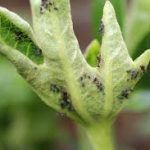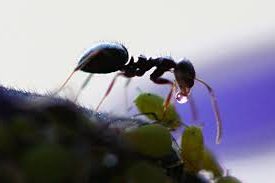
Now that we’re feeling better about fungus growing in the basement, let’s look at what we never want to grow there. Because, wherever food grows, there they are: wee little things that will fly, creep, and eat their way through your garden if not stopped. An unpleasant enough sight outside; the sight of garden pests inside the home is somehow so much worse; after all, it’s an invasion of your living space. Clearly, they’ve invited themselves; question is, how to show The Uninvited the door?
Where they come from
The Uninvited are passengers in the soil, on the leaves, or even in the seeds of plants brought from a nursery, garden center, or your best friend’s garden. You could also be the transport system, bringing them in on your shoes, hands, or clothing. And the great outdoors can always find its way indoors through cracks, tiny holes, or open windows and doors.
Meet The Uninvited
There is a garden variety of pests ready and willing to nosh on your basement garden. What follows is a very brief introduction to some of those you’re most likely to meet.
|
Source: Freegraphicpictures |
Aphids are tiny (0.012-0.3 of an inch long) insects that breed quickly and spread fast. They can create a lot of damage on two fronts: 1) by feeding on the sap of a plant, they cause it to weaken and die, and 2) by secreting a sugary substance called honeydew. | |
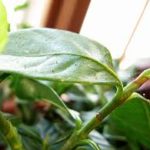 SOURCE: Wikimedia |
Fungus gnats are also tiny (0.079 – 0.315” long). Their feet carry diseases which infect and damage seeds before they can sprout. | |
Honeydew 101Despite the appealing name, honeydew is definitely an uninvited guest. It is the end result of a sap meal. It makes a splendid growing medium for sooty mold, a fungus which covers a plant and blocks sunlight so that the photosynthesis process can’t take place. More Uninvited Because of its sweetness, honeydew attracts other uninvited guests – ants. Some will protect their honeydew supply by guarding the insect producing it from their predators and the weather. Removing Honeydew A very sticky substance, honeydew which can be hard to remove, not only from plants, but skin, furniture, tires, and pavement. Get a good sap or oil remover. Early infestations can be washed away. If you see your plant – any plant, food or nonfood – take on a smooth, shiny look, admire it on the way to the trash can. Get the infected plant away from others and give the underside of the leaves of the other plants a thorough inspection. |
||
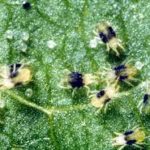
Spider Mites
(0.02 of an inch long) flourish in hot and dry conditions, spinning webs to protect themselves while they chew up plants. They’re small enough to inflict damage on a cellular level.
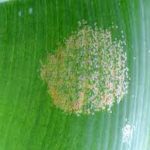
Scale insectsare usually 0.04 to 0.08 of an inch long. They like hiding out on the underside of a plant’s leaves and in its joints. Plants are deprived of their sap which is essential for transporting water and nutrients throughout the plant. The insects can also introduce viral or bacterial diseases into a plant. There are three basic types:
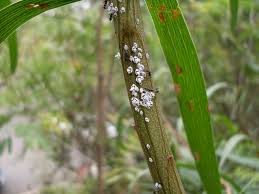
1. mealybugs secrete a protective powder to protect them while they relieve a plant of its sap
2. armored scale bugs hide under a ‘shield’ of shed skins and wax while the use suck up plant sap
3. soft scale bugs produce large amounts of honeydew, opening the door for sooty mold
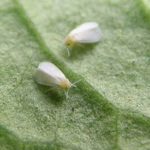
Whiteflies are some of the larger bugs, growing as large as 0.08 of an inch. They live and grow on the underside of leaves, sucking up sap and dropping honeydew onto the leaves below them.
These tiny bugs operate in large groups and can sometimes be mistaken for the natural growth of a plant. Anyone even halfway serious about gardening will have at least one good resource to help identify garden pests. (If you haven’t already, check out our review of the top 5 organic gardening books to see what may be useful in growing your garden smarts.)
Getting Rid of The Uninvited
The easiest route is prevention. Before loading plants into your cart or onto your pallet at the nursery or garden shop, carefully inspect:
• leaves, top and underside
• soil
• vegetation
• container bottom
It’s a good idea to inspect them again before planting. If you’re adding new plants to an existing garden, consider having an isolation area where the plants can sit for a day or so to be sure you’ve brought nothing but the plant into your home.
Plant indicators are an early warning system for a garden. They’re planted specifically to draw out pests hiding in the soil or under leaves. If you see uninvited guests on the indicators, you’re seeing a problem that can overtake your garden.
If you find The Uninvited on your plants, try these basic ways to get rid of them:
Be Picky. Remove infected leaves and soil as soon as possible. This is easier if you’re actively monitoring your indoor garden for signs of trouble. The sooner The Uninvited are spotted, the less you’ll have to discard.
Be offensive. The volatile oils of strongly scented plants like mint, rosemary, thyme, or wormwood overwhelm the tiny olfactory system of moths, flies, spiders, and beetles. Repellents containing these scents will encourage pests to stay far away.
Be laboratory clean. Even hydroponic gardens can become a feeding ground for pests. The close proximity of the plants can make inspection harder and infestations easier. Creating a ‘clean room’ policy can go a long way to keeping out The Uninvited:
- Wash hands thoroughly before handling plants.
- Especially if you’ve been around other plants or have just come from outdoors, change your clothing and shoes before getting near your garden.
- Place new plants in an isolation area before adding them to the garden.
- Have a designated set of tools and containers, wash and disinfect them after each use.
- Regularly clean the garden surroundings.
Put The Uninvited on the Menu
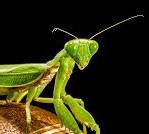
It really is an eat-and-be-eaten world. Many organisms – including beetles, moths, and spiders – will happily dine on whatever chooses to help itself to your garden crop. This is one aspect of integrated pest management, inviting eaters to eat what’s eating your garden.
Ladybugs, spiders, flies, and beetles are insects commonly invited to an outdoor garden. If you can deal with having them indoors, learn more about them at the Beneficial Predators page at the University of California at Davis.
Personally, I think a praying mantis is one of the coolest looking insects anywhere. But when it comes to gardens, you’ll want to keep them away. The problem is their nondiscriminatory policy of eating any insect they encounter. ANY. As in cannibalism. They aren’t the only will-eat-anything-moving insect so if you want to work with beneficial predators, do your homework on which insects help, and which harm, the particular plants in your garden and especially in your living space.
Non-toxic Pesticides
NOne basic reason for wanting to grow your own food is to cut down on unwanted exposure to pesticides. But take care, natural pesticides can also kill beneficial insects. Natural methods of pest removal include:
- diatomaceous earth – a powder made from the fossilized remnants of algae, it contains large amounts of silica which dries the exoskeleton of insects, basically suffocating them.
- soap/water/oil solutions sprayed directly on aphids, mealybugs, or thrips smother and poison.
- Neem is a powerful plant native to India where it is used for a large variety of illnesses. Used properly, explains Discover Neem, it will kill The Uninvited while preserving The Invited. Look for more information there, along with DIY recipes for making your own neem solution
- Adjusting the environment. Mites like a low humidity, warm environment. Make them very uncomfortable by adjusting the room’s temperature and humidity. These adjustments can also help prevent the growth of unwanted fungi and molds.
Enjoy Your Invited Guests
If the basement is a little-used space in your house, a garden may be just the impetus needed to spend more time down there. For example, those ideas about a spare room, study, exercise zone, or home office to use up all that open space may come closer to being a reality.
Bringing living things into any space can inspire lingering. A basement garden can refresh the entire house. So, enjoy your basement, content that the only living things there are those you’ve chosen to invite – plant, pet, or human.
In what may be the last chapter of this basement garden series, Chapter 5 explores the art of companion gardening, grouping plants in a mutually beneficial way.

